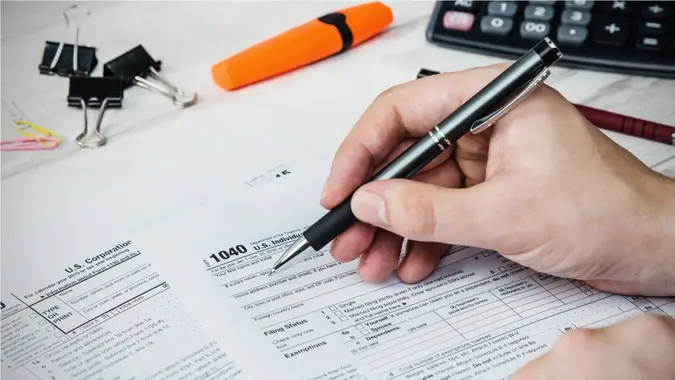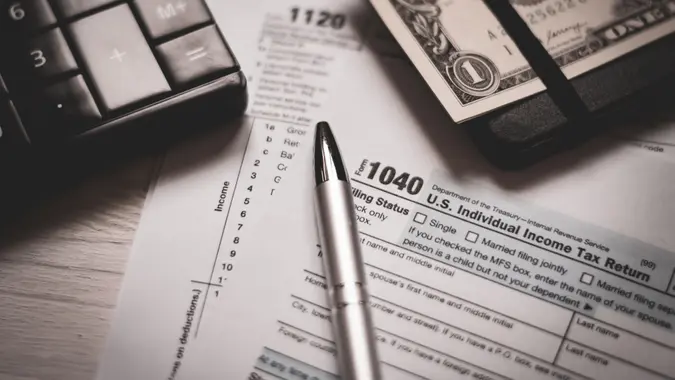I’m a Tax Accountant: Here Are the 5 Best Ways To Get an Extra $2K Back Next Year

Commitment to Our Readers
GOBankingRates' editorial team is committed to bringing you unbiased reviews and information. We use data-driven methodologies to evaluate financial products and services - our reviews and ratings are not influenced by advertisers. You can read more about our editorial guidelines and our products and services review methodology.

20 Years
Helping You Live Richer

Reviewed
by Experts

Trusted by
Millions of Readers
Getting a bigger tax refund should be at the top of everyone’s to-do list, even if that means preparing well before the next tax season. So, even though Tax Day has come and gone in 2025, tax year 2025 should be next on your list to get the most out of what you both pay and get back.
Taxes can be confusing and overwhelming, and it can be hard to figure out what you can do today to affect your return in a meaningful way. With tax law changes happening each year, it’s best to consult with a licensed professional to make sure you’re maximizing your tax return and paying the least amount possible to the IRS.
Miles Brooks, a CPA and the director of tax strategy at CoinLedger, reveals his top five ways to significantly increase your tax return near year.
Take Advantage of Tax Credits
Tax credits help reduce the tax you owe for the year, dollar for dollar. Finding as many tax credits as you qualify for can help significantly increase the amount of money you get back.
“Tax credits can reduce the tax you owe and, thus, increase your tax refund,” Brooks said. “Different tax credits allow you to deduct a certain amount from your tax bill. For example, if you owe the IRS $7,000 in taxes and have tax credits amounting to $1,000, then your tax bill will be $6,000. You might refund some tax credits if you don’t have outstanding tax debt.”
While some tax credits are nonrefundable (meaning they won’t give you a bigger refund), some qualify as refundable. Tax credits such as the EITC or child tax credit have refundable amounts, which can increase your refund by thousands of dollars when claimed.
Consider Different Filing Statuses
There are several different tax filing statuses, but not many taxpayers know that claiming a different status can increase their return.
“If you are married, see if filing as a married or single person offers more advantages,” Brooks said. You can change your filing status, even if it doesn’t describe your exact situation. Keep in mind that you should be careful with this, as there can also be unintended tax liabilities or consequences.
Tax filing status also changes with life events. “If you lost your husband or wife, you could file as a widow or widower if your spouse died more than two years ago,” Brooks said. “The status you choose when filing will affect your deduction.”
Divorce also has an impact on your status. For example, if you are divorced but retain custody of your children, filing as head of household can increase your standard deduction to $21,900 vs. the $14,600 deduction for single filers. Depending on your tax rate, this can net you thousands of dollars more.
Itemize Your Deductions
Itemizing your deduction may be able to give you a bigger refund. Itemizing is claiming deductions for qualifying expenses paid throughout the year. The expenses include things like property taxes, private mortgage insurance, student loan interest paid, state and local sales tax, and charitable donations.
“Most people do not bother to itemize their deductions,” Brooks said. “However, you can improve your refund by itemizing deductions. If itemizing does not apply for this year, it can work in the future.”
While the standard deduction for a single filer is $15,000 in 2025, if you had more than that amount in expenses, you should itemize your deductions. This will net you a lower tax burden and (potentially) a bigger refund.
Remember To Deduct Worthless Investments
Did you lose any money last year? Maybe some crypto investing didn’t pan out? You can use those losses to lower your taxes for the year.
Brooks said, “If you have an investment that brought about a loss or a bad debt, you can describe it and deduct it. You must, however, describe how you put your efforts into the investment and share how it made losses or why the bad debt is worthless.”
In addition to poor investments, if you had any money or assets stolen from you, you can deduct the value of those as well.
Contribute To Tax-Deductible Retirement Accounts
One of the best ways to lower your tax burden and increase your refund (and your wealth) is to invest. But don’t just invest in any brokerage account; focus on tax-deductible retirement accounts. Brooks said one of the best ways to do this is by “maximizing your 401(k) by the end of the year… will help maximize your tax refund.”
In addition to your 401(k) account at work, consider maxing out a traditional IRA account. This is another tax-deductible retirement account that allows you to remove the contributions from your income for the year.
As of 2025, you can contribute up to $23,500 if you’re under 50. If you’re over age 50, you can contribute an additional $7,500 in catch-up contributions, or $7,000 into a traditional IRA (or $8,000 if age 50 or older). That is $31,000 in deductions you can add to your tax return that could result in thousands of dollars back in your pocket. Not to mention efficiently growing your retirement account.
Final Take To GO
The bottom line is that tax returns can be stressful, but if you focus on maximizing your return using these strategies, you could easily increase your refund by $2,000 (or more). It’s important to understand what tax deductions and credits you qualify for and how you can increase your refund with a few simple moves. With the ever-changing landscape of U.S. taxes, it is wise to hire a licensed tax professional to help you stay in compliance while potentially increasing your refund for next year.
Caitlyn Moorhead contributed to the reporting for this article.
More From GOBankingRates
Sources
- Miles Brooks, CoinLedger
 Written by
Written by  Edited by
Edited by 

























